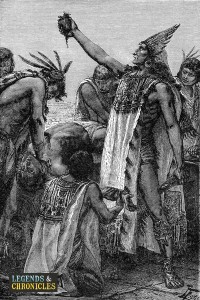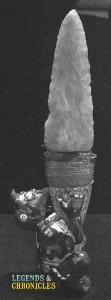Aztec Human Sacrifices
The ancient Aztec people believed that sacrificing would appease their many gods, a ritual that including human sacrifices, and is one of the most unique factors associated with the Aztec people.
The sacrifice of animals was a common practice for which the Aztecs bred all kinds of animals including dogs, eagles, jaguars and deer. Objects were also sacrificed by the Aztecs by being broken and then offered to the gods. Self-sacrifice was also common, the Aztec people would taint maguey thorns with their own blood from their tongue, ear lobes, or genitals, and this act was a sort of personal penance to the gods and purely down to the individual.
However, the Aztecs most gruesome and violent aspect of their culture was their religious practice of human sacrifice, known as tlamictiliztli. The foundation of this practice lies on their myths, rituals, and belief system of how the Aztecs viewed the cosmos and the universe. In the ‘Legend of the five suns’, it was believed that the gods sacrificed themselves so that the human race may live on. The Aztecs thought they were indebted and wanted to appease their gods, so they would repay them by providing the greatest gift and sacrifice of all, human life. The Aztecs also believed that this act would ensure the existence of the human race, and ultimately themselves because the sun rising was dependent on it.
The Aztec chosen ones
The majority of the human sacrifices the Aztecs used were actually warriors that were captured in battle. It was however a great honour to be chosen to be sacrificed because it would mean that they would join the sun god, of course not everyone wanted to meet the sun god. Slaves were also sacrificed if they have already been sold three times, the Aztecs considering them having run their course. Some individuals were also chosen to impersonate gods and are called Ixiptla, which was the same term used for wooden, stone and dough images of the Aztec gods. The gods portrayed by the Ixiptla were of the sun, moon, winds and the sacrifices had the duty to appease these natural forces to bring fertility to the people.
It was believed that even the chosen human sacrifice embraced this destiny. The human sacrifices were treated as gods and given everything they want for a year, as a sort of way to give them a reward for their sacrifice. It was even believed that the most handsome of the Aztec people were chosen for this service. After the Aztec sacrifices were killed, their skin and skulls were kept as holy relics, and according to the Aztecs, the way one died determined the type of afterlife they would enjoy.
The first human sacrifice reported in the sources of Aztec history was the sacrifice and skinning of the daughter of the king Coxcox of Culhuacan, and this sacrificial story is a part of the legend of the foundation of Tenochtitlan.
The types of sacrifices performed by the Aztecs
As we mentioned earlier, the Aztecs believed that the way you died would determine your treatment and style of life in the afterlife. The types of sacrifices the Aztecs practised were decapitation, dismemberment, drowning, piercing by arrows, gladiatorial also known as tlahuahuanaliztli, or the most common one, extraction of the heart, which was known as tlacamictiliztli.
Tools and materials used by the Aztecs in sacrifice
Sacrifices were so important to the Aztec people that they even had unique tools for the job. The main materials used for human sacrifice included a flint knife called tecpatl, which was typically ornate and fastidiously designed. The techcatl was the sacrificial stone the Aztecs used, and a cuauhxicalli was the container that held the hearts of the sacrificial victims.
Aztec Sacrifice Locations:
As human sacrifices were religious practices in Aztec society, they took place at holy sites such as The Great Temple in Tenochtitlan, a ball court or even a sacred mountain. The main goal for the Aztecs of course was to get as high as possible so they could most easily offer their sacrifices to their gods.
The largest temples used by the Aztecs for their sacrifices were that of Tllaloc, the rain god, and Huitzilopochtli, the sun god, and these two gods more than likely received the most human sacrifices.
Rituals before and after the Sacrifice
Aztec human sacrifices were performed typically in time with a ritual, a festival, celebrations or a big important Aztec event. Many of their main Aztec myths and festivals were re-enacted with dances and celebration about the creation of the cosmos, and some of the Aztec events that required human sacrifice were the beginning of battles or wars, and the passing of natural disasters, like eclipses or flooding.
Many of the Aztec rituals were carried out depending on the occasion, the reason for the sacrifice or the god that they sacrificed for. As we previously alluded too, some occasions would have dances that were performed before and after a sacrifice. Other times more extreme rituals would be carried out by the Aztecs, for example the skin of the human sacrifice was sometimes flayed and worn by a chosen one to represent a god in festivals, and there were even rumours that the Aztecs ate the flesh of the one who was sacrificed in some circumstances.
After a sacrifices, the Aztecs would bury the bodies, but the sacrifices heads were often cut off first and placed on a stick known as a tzompantli and displayed for all to see. There were also rituals where the sacrifices body was tossed down the stairs of the pyramid towards the cheering Aztec people, who would turn up in droves to watch this presentation to the almighty gods.
Scheduled Aztec festivities
Many of the Aztec ceremonies that were held at the temples followed seasonal and festival calendars, and human Sacrifices were often performed in accordance to the Aztecs 18 months and 20 day calendar. Sacrifices were made on specific days, and there were festivities for each month honouring a specific god.
The specifics of each sacrifice differed depending on the god the Aztecs were trying to appease. For example, young women were drowned for Xilonen, children were sacrificed to Tlaloc, Nahuatl-speaking prisoners to Huitzilopochtli, and a single nahua would volunteer for Tezcatlipoca. And according to Aztec beliefs, it was essential to provide the gods with nourishment in order to prevent the end of the world, which explains why sacrifices were an integral part of their lives.
The end of Aztec human sacrifices
When the Christian Spaniards came to conquer the Aztecs, they were shocked by the human sacrifices the Aztecs would offer up to the gods. One of the first things the Spaniards enforced to the locals was that they must cease these religious practices, along with the Aztecs belief for their gods, their calendar, and even their myths. This change in rules enforced by the Spaniards effectively put an end to one of the most unique traits of the ancient Aztecs, their offering of sacrifices to their gods.

